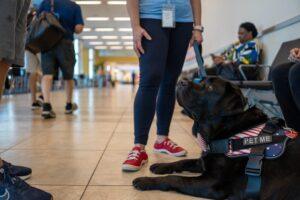Did you know Alliance of Therapy Dogs (ATD) allows you to test with a dog you have had a relationship with for at least 6 months? Being the dog’s owner is not a requirement to become an ATD therapy dog team. There are instances when a person may want to get certified with a dog they do not own. This can include many situations such as: teams that work together and may need to utilize a different dog for a different event, a family member who does not live with the dog but may want to participate in therapy dog work, or an owner who feels they have an amazing therapy dog but does not think they could be a successful handler for that dog.
These are only a few situations where working a dog you do not own may be beneficial. It is important, however, that the handler and dog are comfortable working together in a variety of settings. Here are 3 things to be aware of when preparing for the ATD Certification Test with someone else’s dog:
- The dog is comfortable working with someone outside their immediate family. Every dog is different in their comfort level of working for people outside their family. Some breeds naturally want to bond to 1 person rather than multiple people. Making sure the dog is comfortable working with the person they are testing with is important before showing up for the Handling Assessment. If your dog is concerned about being handled by a person other than their owner, they may be nervous during the ATD Certification Test and may not have the skills to pass with their new handler.
- The dog is comfortable working with a different handler around their owner. If the team being certified plans to do therapy dog work when their owner is present, it is important to make sure the dog can work around its owner. If the dog is very attached to their owner and not able to focus on therapy dog work with a different handler, they could potentially make people they are visiting feel ignored or forgotten. This can have the opposite effect of what a therapy dog visit should be providing.
- The handler knows the dog well enough to support that individual dog during a visit. Every dog has a preference on how they like to visit. Some dogs prefer more hands-on support from their handler, while others might need a bit more space. This can also vary depending on who is handling the dog. It is important that the handler and dog get to practice together in public situations before taking the ATD Certification Test. Learning these things together will set a team up for success and keep everyone safe on a visit after they become a certified therapy dog team.
It is important that a therapy dog and their handler are comfortable working together. When situations include high emotion or stress, we want dogs feeling comfortable enough to look to their handler for support. A good working relationship will build a strong foundation for future visits. With a strong foundation, teams will know how to work together comfortably to keep everyone safe and happy during their therapy dog visits. This is the goal of a good ATD therapy dog team.





